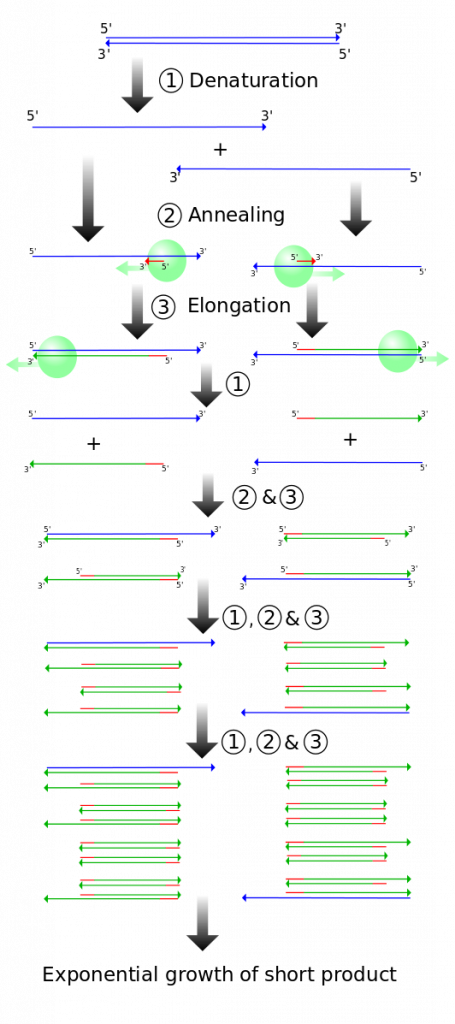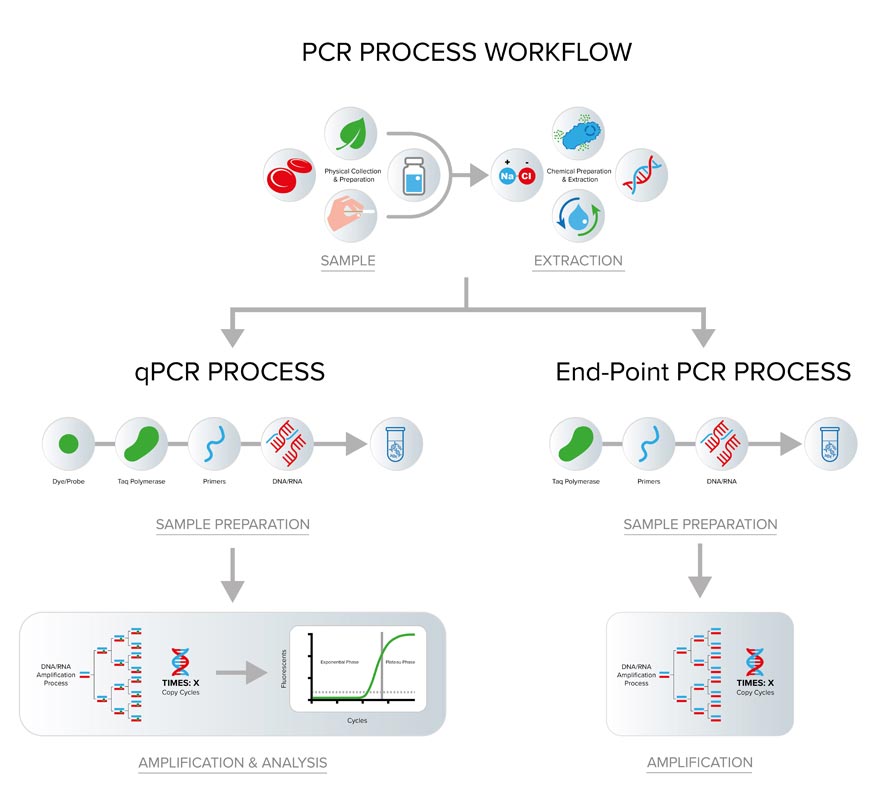Describe the Three Main Steps in Dna Profilin Using Pcr
The double-stranded DNA template is denatured into two single-stranded DNA templates which occurs at 94 for 1 minute. Restriction absorption or PCR intensification.

Dna Isolation Gel Electrophoresis And Pcr Principles Of Biology
The PCR process has 4 stepscollection preparation amplification and post PCR clean-up.

. It begins with a segment of a DNA sample placed in a suitable tube along with the reagents and chemicals listed above. An automated process to replicate short targeted segments of DNA into millions of copies. Applications of DNA Fingerprinting.
3 basic PCR steps include. Often only small amounts of DNA are available for forensic analysis so the STRs at each genetic locus are copied many times using the polymerase chain reaction PCR to get enough DNA to make. Chemicals are added to break open the cells extract the DNA and isolate it from other cell components.
Tap card to see definition. View the full answer. To amplify a segment of DNA using PCR the sample is first heated so the DNA denatures or separates into two pieces of single-stranded DNA.
This source could be a single strand of hair semen blood a single drop will work too saliva cheek cell etc. Up to 24 cash back The process of DNA fingerprinting starts with isolating DNA from any part of the body such as blood semen vaginal fluids hair roots teeth bones etc. A _____ b.
Each step -- denatauration alteration of structure annealing joining and extension -- takes place at a different temperature. Next an enzyme called Taq polymerase synthesizes - builds - two new strands of DNA. The reaction mixture is heated to 95 degress C to denature the DNA into single strands.
3 basic steps of PCR process. Get Your Custom Essay on 3. Restriction fragment length polymorphism RFLP and polymerase chain reaction PCR amplification of short tandem repeats STRs are two main DNA tests widely used for DNA fingerprinting.
Scientists use a powerful technique called Polymerase Chain Reaction PCR to make millions of copies of the. Restriction fragment length polymorphism RFLP. The polymerase chain reaction is a three step cycling process consisting of defined sets of times and temperatures.
Scientists only need a tiny amount of DNAaround 100 microgramsto construct a DNA profile from a crime scene sample. Thus every individual has a particular composition of VNTRs and this is the main principle of the DNA fingerprinting technique. Collection of organic example blood spit buccal swab semen or solid tissue.
Therefore a primer is required. The PCR technique is based on the enzymatic replication of DNA. Describe the three main steps in DNA profiling using PCR bI 4.
Agarose gel electrophoresis slim. Describe the three main steps in DNA profiling using PCR. The thermal cycler takes the solution.
Some of the major steps involved in polymerase chain reaction in DNA sequence are. Thus more nucleotides are added to. Describe the three main steps in DNA profiling using.
Click card to see definition. Nucleotides and DNA polymerase enzymes are added along with primer pieces of DNA which will bind to the sample DNA and give the polymerases a starting point. To begin with one should have a source of DNA sample.
At 94 C 2012 F the double-stranded DNA melts and opens into two pieces of single-stranded DNA. Amplified restriction fragment polymorphism AFLP is a PCR-based DNA fingerprinting technique. Explain why as many as 10 STR sites are used to gain a DNA profile for forensic evidence.
Annealing Primer to Target Sequence 3. Individuality It helps to differentiate one human being from another with the exception of monozygotic twins. The PCR machine steps happen in the amplification step.
DNA is contained within the nucleus of cells. The next step is to extract the DNA sample from its source. The PCR cycle has following three steps.
The DNA polymerase can add a nucleotide to the pre-existing 3-OH group only. In this step the two strands of double-stranded DNA are separated by heating to 94C for 2 minutes. The oligonucleotide primers anneal to their complementary DNA sequences on one of the two.
In PCR a short segment of DNA is amplified using primer mediated enzymes. Denaturing in which the double-strands of template DNA is heated to separate into two single strands. Denaturing when the double-stranded template DNA is heated to separate it into two single strands.
The system of DNA profiling used today is based on PCR and uses simple sequences or short tandem repeats STR. End of the First PGR Cycle. Collect a sample and extract its DNA.
OBlozone International 2001-2008 Photocopying Prohibited Dont use plagiarized sources. Tap card to see definition. The polymerase chain reaction PGR amplifies a single piece of DNA across several orders of magnitude see figure 62.
Paternity or Maternity Disputes It helps to find out the real genetic mother father and offspring. Annealing when the temperature is lowered to enable the DNA primers to attach to the template DNA. The tube is placed into the PCR machine or thermal cycler.
Amplify the telltale regions. Extending when the. The two strands separate because the hydrogen bonds between the base pairs break.
Click again to see term. This is necessary for Taq pol to generate copies of the target DNA sequence on the template. DNA Polymerase synthesises new strands of DNA complementary to the template DNA.
Human Lineage It is also used to study human lineages. The applications of DNA fingerprinting are as follows. The extraction process is devised in a.
In many situations there is only a small amount of DNA available for DNA fingerprinting. Click card to see definition. Annealing in which the temp.
Tap again to see term. PCR cycles can be repeated until the sample DNA has been copied many times in the lab if necessary. The DNA fragments that result are then separated and detected using electrophoresis.
During criminal investigations the hair semen or blood of the suspect is collected for further analysis. Find step-by-step Biology solutions and your answer to the following textbook question. The polymerase chain reaction process serves to raise the number of DNA fragments.
PCR is a technique to make multiple copies amplify of small sections of DNA. These STR loci locations on a chromosome are targeted with sequence-specific primers and amplified using PCR. Thats so little a few cells from saliva on a straw will do.
Polymerase chain reaction PCR is the next step in the process. In AFLP analysis bacterial genomic DNA is digested with restriction enzymes ligated to adapters and a subset of DNA fragments are amplified using primers containing 16 adapter defined sequences with one additional arbitrary nucleotide. Denaturation by Heat 2.
There are three main steps in PCR.


No comments for "Describe the Three Main Steps in Dna Profilin Using Pcr"
Post a Comment